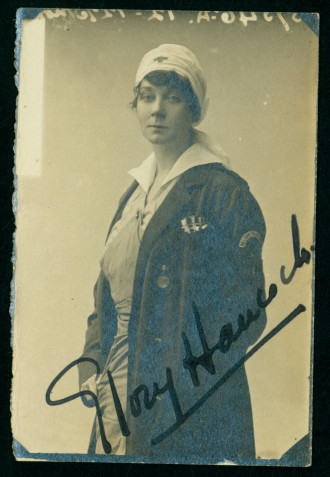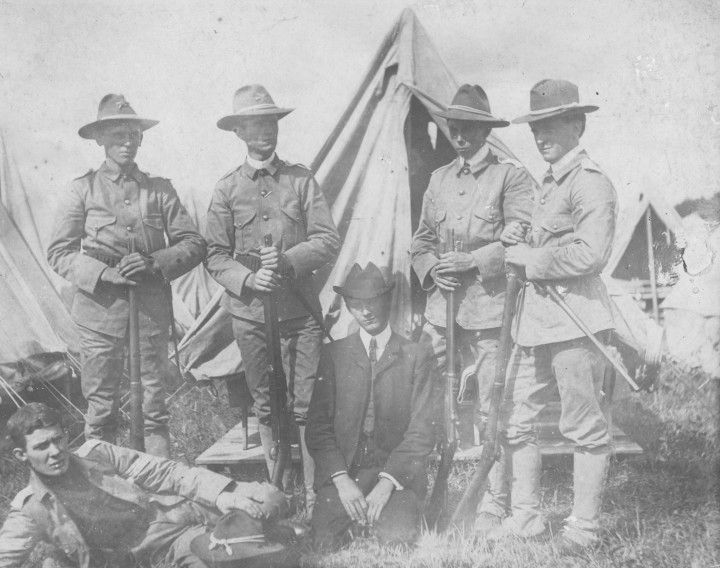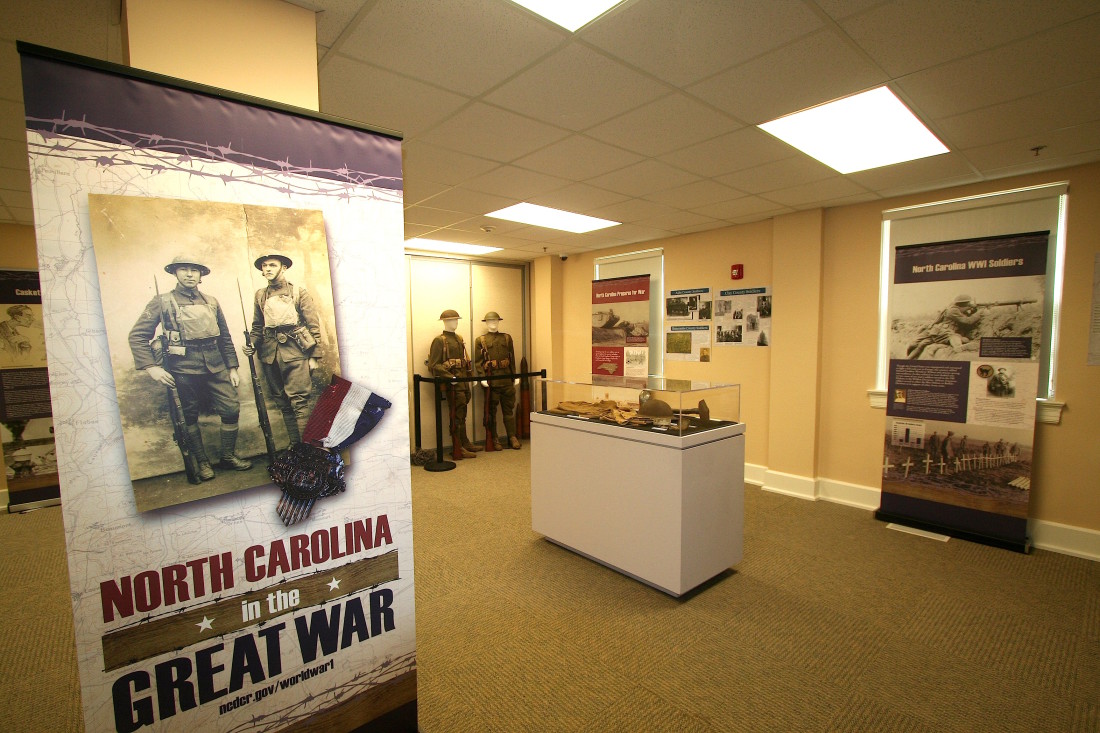While Americans anxiously followed reports of World War I raging across Europe, Asheville’s first Great War casualty was already receiving a hero’s funeral in France.
Kiffin Rockwell, widely acknowledged as the first American to shoot down a German plane while serving in the Escadrille Lafayette fighter pilot squad, was himself shot down in September 1916, more than six months before the U.S. formally entered the conflict.
To this day, “He’s a well-known, very respected American hero over in France,” says Jeff Futch, curator of North Carolina in the Great War, now on display in East Asheville. The exhibit is a project of the Western Office of the state Department of Natural and Cultural Resources on Riceville Road. “They have a huge monument to the Lafayette Escadrille over there and still lay flowers at his grave.”
And though those battles were fought half a world away, WWI had a profound and lasting impact on Western North Carolina, both among those who fought in the European theater and on the homefront.

As the state gears up for a big centennial retrospective on North Carolina’s involvement in the Great War, local researchers have worked to bring WNC residents’ stories and experiences to contemporary audiences.
Remembering the Great War
Next April, says Futch, the state agency will open an expansive exhibit at the North Carolina Museum of History in Raleigh, to mark the centennial of America’s entrance into the war.
As a kind of preview, Futch decided to showcase WNC’s involvement in the conflict with a smaller exhibit in the Western Office’s Heritage Room Gallery. Drawing on museums and repositories from around the region, Futch has assembled a small but eclectic collection of artifacts, memorabilia and stories.
“We’ve got an original uniform and helmet from Cherokee County; we also have a shaving kit, shovel and canteen from Burke County,” he notes. “Ashe County let us borrow several weapons from the era, and Clay County loaned us a little German helmet, which came from a veteran that brought that back.”
Closer to home, the Swannanoa Valley Museum contributed a newspaper announcing the war’s end, with a local woman’s notes and thoughts written in the margins, and a hymnal used by President Woodrow Wilson during the war, which the museum had on loan from the Presbyterian Church at Montreat.
The state’s Western Regional Archives is also sponsoring a Nov. 12 talk by history professor Ellen Pearson of UNC Asheville and student Ashley McGhee, who’ll speak about their work documenting and digitally cataloging WWI experiences from various mountain communities as part of the nationwide Century America project.
“Johnny has gone for a soldier”
“Asheville was like any other Appalachian mountain town during this time, in that it retained its small-town roots and cultural heritage,” says McGhee, a senior at UNC Asheville. “But it was also like other American towns, in that the war inspired a deep sense of patriotism for one’s country and one’s fellow Americans.”
Men like Rockwell weren’t the only Ashevilleans honored for their early service. Madelon “Glory” Battle Hancock, an Asheville native who married a British man before the war, served on the front lines as a nurse from the start of the war. According to online resources from Appalachian State University, three countries — Great Britain, Belgium and France — awarded Hancock a total of 12 medals for her fearless devotion to tending the sick and wounded.
When President Wilson officially declared war on the German Empire in the spring of 1917, local educational outposts like Asheville School and the Asheville Farm School (now Warren Wilson College) soon found themselves nearly emptied of students of fighting age.
“The army and navy have taken all of the young men of the mountains,” Elizabeth Williams, a teacher at the Farm School, wrote in a 1918 letter to the Presbyterian Board of Missions, adding that the school was forced to rely on the younger students to perform the daily duties around campus. “These younger boys must be trained to take their places, as many [older boys] may never return.”

For the young fighting men — many of them away from the mountains for the first time — the war brought harsh realizations. Meredith Ashley, an Asheville School student who fought at Verdun, wrote to his alma mater, “Our experiences here make the other front seem like a toy war; it has been very bitter fighting. … such utter devastation is hard to conceive.”
All in all, 18 Asheville School alumni served in various theaters and military branches during WWI; eight of them perished. The Asheville Farm School, meanwhile, sent more than 108 young men into the fray, at least one of whom was killed; several others were severely wounded.
Battling the color bar

Students weren’t the only mountain residents to lend a hand in the fighting. Several panels at the Western Regional Archives exhibit detail the service of notable locals like Burke County’s Sam Ervin (who later served as a U.S. senator and chaired the Senate’s Watergate Committee), and Earl W. Eller (Asheville’s mayor from 1951-69).
Women and minorities also played important parts in the war effort, notes McGhee. “Only now, through research, such as what we undertook for the Century America project, are we seeing how important the impact of these men and women was on [issues of] gender and race in Western North Carolina.”
In Burke County, more than 113 African-American residents enlisted to fight for their country during the height of the Jim Crow laws, distinguishing themselves in the eyes of foreign commanders while also garnering recognition at home.
“There was this interesting little blurb from The News Herald of Morganton at the time about Adolphus Henry Lynch, an African-American sergeant who was killed in battle,” says Futch. “They published a bit of the letter his commanding officer had written about him. As an African-American soldier coming from the South in 1918 — that was really interesting.”
Others, like Willard Sterling Browning, helped tend one of the Army’s most valuable commodities. “He served in the U.S. Army Remount Service. They cared for the over 240,000 horses, mules, dogs and service animals the Army used,” Futch explains. Despite all the changes the conflict brought to the business of war, “We weren’t totally mechanized, so there were a lot of horses and mules used. Someone had to care for them.”
The homefront
It’s easy to get swept up in the heroics and struggles played out in faraway battles, but the war effort also extended into the Southern Appalachians. Williams, the Asheville Farm School secretary, writes of students producing thousands of gallons of canned goods to send abroad and holding practice drills on campus, to be ready in case they were drafted.
As wounded veterans began to trickle back stateside, several hospitals and treatment centers were established around the region. General Hospital No. 19, colloquially known as “the Oteen Hospital,” eventually morphed into today’s Charles George VA Medical Center.
“The area was pretty well-known for respiratory and tuberculosis care,” says Futch, “and so with gassed veterans, and those suffering from other respiratory illnesses, that’s what this particular hospital was known for.”
In Madison County, the little town of Hot Springs hosted “enemy alien” detainees from 1917 until the war’s end. “German sailors who happened to be in American ports when the war broke out, they couldn’t let them leave,” Futch notes.
Instead, 2,300 German nationals were held in Hot Springs, bringing their culture and traditions with them. According to the Department of Cultural Resources’ “NC History Today” blog, the Germans built a makeshift Bavarian village, complete with houses, a church and even a carousel, near what’s now the Hot Springs Resort and Spa.
“A German brass band provided concerts for the townspeople every Sunday afternoon,” notes the blog. “After living in the camp for 17 months, many internees developed close friendships with local families; some returned to visit after the war ended.”

Lasting legacy
While subsequent conflicts have largely displaced World War I in the popular memory, Futch says many of the changes the war brought to WNC laid the groundwork for institutions and beliefs that reverberate in the present day.
“Certainly the cultural exchange,” says Futch. “We think about Rosie the Riveter in World War II, but women were very involved in different ways in World War I too, which empowered some of them to start thinking about suffrage.”
The conflict also brought darker feelings to the forefront. “During and after the war, there was a strong anti-immigrant — really an anti-‘others’ — sentiment,” he notes. “There was a rebirth of the Ku Klux Klan after the war. Many African-Americans left the South for the open manufacturing jobs up North during the war. All those things lead down to today in various ways.”
Projects like Century America and the upcoming state exhibit, says McGhee, can help bring these often obscure stories to life for contemporary people and shed light on the connections with our own time.
“The old saying ‘Those who cannot remember the past are condemned to repeat it’ comes to mind,” she says. “In today’s globalized world, we’re at an ever-increasing risk of treading on one another’s rights and sensibilities. Only by listening and learning from one another’s stories and histories can we find common ground and mutual respect for one another, which will enable us to create a bright future for Asheville and the world we live in.”
For more information on the North Carolina in the Great War exhibit, check the website (visitncdcr.gov/about/history/western-office).




Excellent article – The Great War or World War One, is rapidly becoming a “forgotten war” in the US….we only participated actively during the last year of the War, but lost around 116,000 lives in that brief time – many to the Spanish Flu epidemic that swept thru military bases and training camps. Your last photo in the article shows the state of unpreparedness of the US military in 1917 – the uniforms and weapons are from the Spanish-American War era, as many State Militia and National Guard units were equipped with hand-me-downs from the Regular forces. Kiffin Rockwell’s brother, Colonel Paul Rockwell, lived in Asheville for many years and died in 1985.
Thanks for reading and sharing some more information and insight on the topic Phil! The Spanish flu certainly had a devastating impact both overseas and on the home front. Unfortunately, due to time and space limits, I did not have the time to explore that aspect of the war and it’s aftermath. It is definitely a large part of the war’s aftermath effects on the region and across the world.